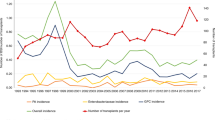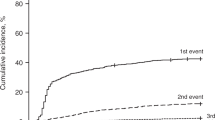Summary:
To identify overall and site-specific rates of nosocomial infections (NIs) during the neutropenic, as compared to the non-neutropenic stage of treatment in adult recipients of allogeneic and autologous bone marrow transplantation (BMT) and peripheral blood stem-cell transplantation (PBSCT), a prospective, 54-month study was started at the Haematological Stem Cell Transplantation Unit of the University Hospital of Freiburg, Germany. NI types were identified using modified CDC definitions. A total of 351 patients (14 256 in-patient days, 5026 neutropenic days) were investigated (316/90% allogeneic, 35/10% autologous; BMT: 119 patients, PBSCT: 234 patients). The mean length of neutropenia was 14.3 days (range: 0–66). Antimicrobial prophylaxis for allogeneic transplantation consisted of ciprofloxacin, trimethoprim/sulpha-methoxazole, fluconazole, and metronidazole. In total, 239 NIs were identified in 169 patients (48.1%), and of these 171 (71.5%) occurred during neutropenia (34.0 NIs per 1000 days at risk). The main pathogens were coagulase-negative staphylococci (36.3%), Clostridium difficile (20.4%), and enterococci (10.0%). Site-specific incidence densities during neutropenia vs non-neutropenia were: 13.9 vs 1.6 bloodstream infections (all central line-associated), 11.9 vs 1.8 pneumonias, 3.0 vs 2.9 gastroenteritis, and 1.6 vs 0.3 urinary tract infections. The greatest number of NI in BMT and PBSCT recipients is acquired during neutropenia, and multicentre surveillance programmes should focus on this.
This is a preview of subscription content, access via your institution
Access options
Subscribe to this journal
Receive 12 print issues and online access
$259.00 per year
only $21.58 per issue
Buy this article
- Purchase on Springer Link
- Instant access to full article PDF
Prices may be subject to local taxes which are calculated during checkout

Similar content being viewed by others
Notes
*Since January 2002: German National Reference Centre for Surveillance of Nosocomial Infection, Germany
References
Perl TM, Chotani R, Agawala R . Infection control and prevention in bone marrow transplant patients. In: Mayhall CG (ed.). Hospital Epidemiology and Infection Control, 2nd edn. Lippincott Williams &Willkins: Philadelphia, 1999, pp 803–844.
Carlisle PS, Gucalp R, Wiernik PH . Nosocomial infections in neutropenic cancer patients. Infect Control Hosp Epidemiol 1993; 14: 320–324.
Emmerson AM . The impact of surveys on hospital infection. J Hosp Infect 1995; 30 (Suppl.): 421–440.
Dettenkofer M, Daschner F . Cost-effectiveness of surveillance methods. In: Emmerson AM, Ayliffe GAJ (eds). Surveillance of Nosocomial Infections. Ballière Tindall: London. Bailliere's Clin Infect Dis 1996; 3: 289–301.
Gastmeier P, Sohr D, Just HM et al. How to survey nosocomial infections. Infect Control Hosp Epidemiol 2000; 21: 366–370.
Gaynes RP, Horan TC . Surveillance of nosocomial infections. In: Mayhall CG (ed.). Hospital Epidemiology and Infection Control, 2nd edn. Lippincott Williams &Willkins: Philadelphia, 1999, pp 1285–1317.
NNIS. National Nosocomial Infections Surveillance (NNIS) System report, data summary from January 1992–April 2000, issued June 2000. Am J Infect Control 2000; 28: 429–448.
Howell PB, Walters PE, Donowitz GR et al. Risk factors for infection of adult patients with cancer who have tunnelled central venous catheters. Cancer 1995; 75: 1367–1375.
Hunter AE, Haynes AP, Russell NH . Bone marrow transplantation: current situation, complications and prevention. J Antimicrob Chemother 1995; 36 Suppl. B: 119–133.
Kruger W, Russmann B, Kroger N et al. Early infections in patients undergoing bone marrow or blood stem cell transplantation – a 7 year single centre investigation of 409 cases. Bone Marrow Transplant 1999; 23: 589–597.
Ninin E, Milpied N, Moreau P . Longitudinal study of bacterial, viral, and fungal infections in adult recipients of bone marrow transplants. Clin Infect Dis 2001; 33: 41–47.
Sparrelid E, Hägglund H, Remberger M et al. Bacteraemia during the aplastic phase after allogeneic bone marrow transplantation is associated with early death from invasive fungal infection. Bone Marrow Transplant 1998; 22: 795–800.
Williamson ECM, Millar MR, Steward CG et al. Infections in adults undergoing unrelated donor bone marrow transplantation. Br J Haematol 1999; 104: 560–568.
Marena C, Zecca M, Careinini ML et al. Incidence of, and risk factors for, nosocomial infections among hematopoietic stem cell transplantation recipients, with impact on procedure-related mortality. Infect Control Hosp Epidemiol 2001; 22: 510–517.
Gratwohl A, Passweg J, Baldomero H, Urbano-Ispizua A; European Group for Blood and Marrow Transplantation (EBMT), Hemato stem cell transplantation activity in Europe 1999: Bone marrow Transplant 2001; 27:899–916.
Perl TM . Surveillance, reporting, and the use of computers. In: Wenzel R (ed.). Prevention and Control of Nosocomial Infections. 3rd edn. Williams & Willkins: Baltimore, 1997, pp 127–161.
Garner JS, Jarvis WR, Emori GT et al. CDC definition for nosocomial infections. Am J Infect Control 1988; 16: 128–140.
Rosner B . Fundamentals of Biostatistics, 3rd edn. Duxburg Press: Boston, 1990, p 88ff.
Johnson PW, Simnett SJ, Sweetenham JW et al. Bone marrow and peripheral blood stem cell transplantation for malignancy. Health Technol Assess 1998; 2: 1–187.
Margolis J, Borrello I, Flinn IW . New approaches to treating malignancies with stem cell transplantation. Semin Oncol 2000; 27: 524–530.
Jacobs P, Hailey D, Turner R et al. Allogeneic stem cell transplantation. An economic comparison of bone marrow, peripheral blood, and cord blood technologies. Int J Technol Assess Health Care 2000; 16: 874–884.
Hui CH, To LB . Peripheral stem cells in bone marrow transplantation Future prospects. Baillieres Best Pract Res Clin Haematol 1999; 12: 307–318.
Saba N, Abraham R, Keating A . Overview of autologous stem cell transplantation. Crit Rev Oncol Hematol 2000; 36: 27–48.
DiPersio JF, Khoury H, Haug et al. Innovations in allogeneic stem-cell transplantation. Semin Hematol 2000; 37 Suppl. 2: 33–41.
Hanna H, Raad I, Gonzalez V et al. Control of nosocomial Clostridium difficile transmission in bone marrow transplant patients. Infect Control Hosp Epidemiol 2000; 21: 226–228.
Klausner JD, Zukerman C, Limaye AP et al. Outbreak of Stenotrophomonas maltophilia bacteremia among patients undergoing bone marrow transplantation: association with faulty replacement of handwashing soap. Infect Control Hosp Epidemiol 1999; 20: 756–758.
Kirkpatrick BD, Harrington SM, Smith D et al. An outbreak of vancomycin-dependent Enterococcus faecium in a bone marrow transplant unit. Clin Infect Dis 1999; 29: 1268–1273.
Chadwick PR, Oppenheim BA, Fox A et al. Epidemiology of an outbreak due to glycopeptide-resistant Enterococcus faecium on a leukaemia unit. J Hosp Infect 1996; 34: 171–182.
Kolbe K, Domkin D, Derigs HG et al. Infectious complications during neutropenia subsequent to peripheral blood stem cell transplantation. Bone Marrow Transplant 1997; 19: 143–147.
Hughes WT, Flynn PM, Williams BG . Nosocomial infection in patients with neoplastic disease. In: Mayhall CG (ed.). Hospital Epidemiology and Infection Control. Williams & Wilkins: Baltimore, 1996, pp 618–631.
Yuen KY, Woo PC, Hui CH et al. Unique risk factors for bacteraemia in allogeneic bone marrow transplant recipients before and after engraftment. Bone Marrow Transplant 1998; 21: 1137–1143.
Elishoov H, Or R, Strauss N, Engelhard D . Nosocomial colonization, septicemia, and Hickman/Broviac catheterrelated infections in bone marrow transplant recipients. A 5-year prospective study. Medicine (Baltimore) 1998; 77: 83–101.
Kumagai T, Sakamaki H, Tanikawa S et al. Utility and safety of Hickman catheters for venous access after bone marrow transplantation. Intern Med 1998; 37: 286–291.
Lossos IS, Breuer R, Or R et al. Bacterial pneumonia in recipients of bone marrow transplantation. A five-year prospective study. Transplantation 1995; 60: 672–678.
Chakrabarti S, Lees A, Jones SG et al. Clostridium difficile infection in allogeneic stem cell transplant recipients is associated with severe graft-versus-host disease and non-relapse mortality. Bone Marrow Transplant 2000; 26: 871–876.
Collin BA, Leather HL, Wingard JR et al. Evolution, incidence, and susceptibility of bacterial bloodstream isolates from 519 BMT patients. Clin Infect Dis 2001; 33: 947–953.
La Rosa AM, Champlin RE, Mirza N et al. Adenovirus infections in adult recipients of blood and marrow transplants. Clin Infect Dis 2001; 32: 871–876.
Jantunen E, Ruutu P, Niskanen L, Volin L et al. Incidence and risk factors for invasive fungal infections in allogeneic BMT recipients. Bone Marrow Transplant 1997; 19: 801–808.
Haley RW, Culver DH, White JW et al. The efficacy of infection surveillance and control programs in preventing nosocomial infections in U.S. hospitals. Am J Epidemiol 1985; 212: 182–205.
Dettenkofer M, Ebner W, Els T et al. Surveillance of nosocomial infections in a neurology intensive care unit. J Neurol 2001; 248: 959–964.
Dykewicz CA . Summary of the guidelines for preventing opportunistic infections among hematopoietic stem cell transplant recipients. Clin Infect Dis 2001; 33: 139–144.
Acknowledgements
We thank all staff of the HSCT unit of the University Hospital of Freiburg and D Lawrie-Blum for help with the preparation of the manuscript.
Author information
Authors and Affiliations
Rights and permissions
About this article
Cite this article
Dettenkofer, M., Ebner, W., Bertz, H. et al. Surveillance of nosocomial infections in adult recipients of allogeneic and autologous bone marrow and peripheral blood stem-cell transplantation. Bone Marrow Transplant 31, 795–801 (2003). https://doi.org/10.1038/sj.bmt.1703920
Received:
Accepted:
Published:
Issue Date:
DOI: https://doi.org/10.1038/sj.bmt.1703920
Keywords
This article is cited by
-
Anforderungen an die Infektionsprävention bei der medizinischen Versorgung von immunsupprimierten Patienten
Bundesgesundheitsblatt - Gesundheitsforschung - Gesundheitsschutz (2021)
-
Diagnosis and management of gastrointestinal complications in adult cancer patients: 2017 updated evidence-based guidelines of the Infectious Diseases Working Party (AGIHO) of the German Society of Hematology and Medical Oncology (DGHO)
Annals of Hematology (2018)
-
Prävention von Infektionen, die von Gefäßkathetern ausgehen
Bundesgesundheitsblatt - Gesundheitsforschung - Gesundheitsschutz (2017)
-
Prediction of central venous catheter–related bloodstream infections (CRBSIs) in patients with haematologic malignancies using a modified Infection Probability Score (mIPS)
Annals of Hematology (2015)
-
Bloodstream infection in paediatric cancer centres—leukaemia and relapsed malignancies are independent risk factors
European Journal of Pediatrics (2015)



